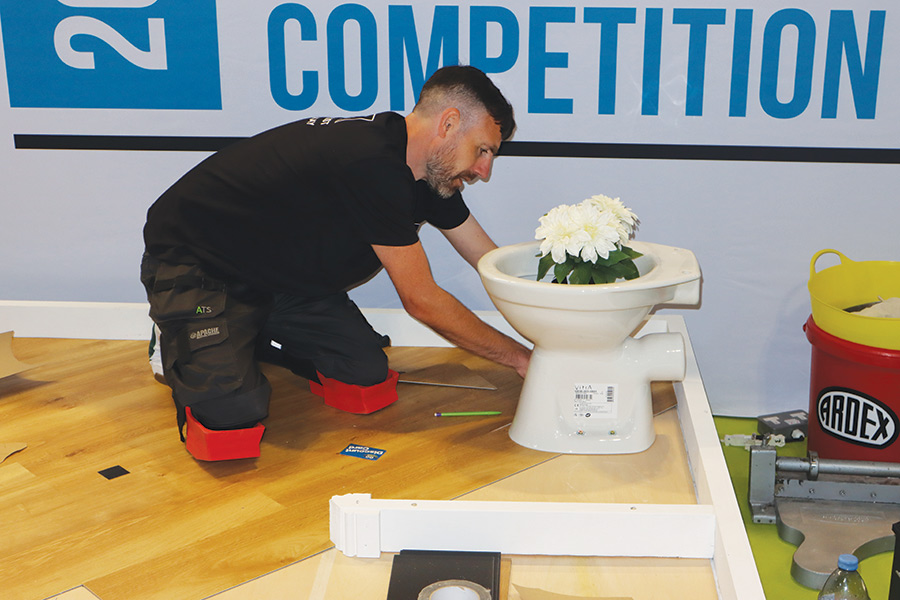THE semifinals of the Floorlayer of the Year competition were very different. Instead of taking place at the FITA training centre in Loughborough, they were held during The Installer Show at the NEC in June.
This meant the semi-finalists had the added pressure of public scrutiny, which is normally only the case at the finals, when the top competitors have been selected.
This year the semi-final required four different fitters each day (12 in total) to install two different LVT products (a large plank and a small herringbone tile) into a platform divided into two rooms with an offset doorway and a toilet pan. The plank tiles were to be laid at 45deg and the herringbone was to be run with the rows square to the room. There was a maximum time of five hours to complete the work and points were lost for any elements not completed.
To add to the pressure, the audience at The Installer Show was not made up of people from the flooring trade, but was a mixture of plumbers, electricians, kitchen and bathroom fitters, and more. Some of them still thought they could do the job much more quickly than the competitors, and they were ready to offer advice such as ‘I’d take that toilet pan out, why haven’t they?’
In spite of the heckling, the event was a fantastic demonstration that there’s a professional way to lay floors, and it’s not just an ‘anyone can do that’ product. I really enjoyed talking to many installers from other disciplines about the importance of flooring installation, and several admitted to having ‘had a go’ and to making basic mistakes that resulted in additional costs.
The most common questions, however, were the same as when the competition is running at the Harrogate Show: How does the judging work? What are the Judges looking for? What makes one fitter’s work better than another’s?
The first category of things the judges look for is the overall appearance of the finished installation. Has the fitter laid the flooring so it’s running in the right direction and laid out in accordance with the brief? Were the tiles centred and running at the correct angle? This was checked and an exact layout scored more highly than one that was slightly off. As this is the competition for the Floorlayer of the Year, the judges’ expectations were high, even though every one of the competitors did a job that would have satisfied even a demanding client.
Points were lost for gaps around the perimeter and obstacles (they had six architraves and a toilet to scribe to), failure to intermix the tiles to randomise the pattern, and for any other visual shortcomings.
The second category of things the judges were looking for covered the methods used by the installers as they worked. How did they set out the areas before they began to lay the tiles? What tools did they use and how well did they use them? Did they select the right adhesive and observe the open time and working time to ensure a good bond? Did they ensure that they cleaned the subfloor before spreading the adhesive and did they take care to avoid pouring out too much adhesive and putting surplus adhesive back into the tub? Nit-picking?
These installers have to show they are the best of the best and simple precautions like that make a lot of difference.
The last category covered things that matter to a customer. Did the fitter check the product was what had been ordered? Did the fitter discuss the proposed layout and whether this met the customer’s expectations? Did the fitter keep the work area neat and free from trip hazards? How well did the fitter handover the finished job to the customer by explaining how to care for the product in the immediate and longer terms?
When all the various aspects of each fitter’s work were scored, the semi-finalists could be ranked and the top five scoring fitters will go through the finals of the Floorlayer of the Year competition at the Harrogate show.
By the time you’re reading this magazine The Flooring Show in Harrogate will be underway and those five will be on the Fitter of the Year stand aiming to win the ultimate accolade. The project will be more complex and they will have a fixed time, spread over two days to complete it. Enjoy watching them at work and if you’re tempted to think you could do better, put your entry in for next year (carpets) or the year after (LVT again) depending on your skillset.
Please click to view more articles about
Latest News

